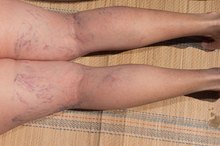Symptoms of an Aneurysm Behind the Knee
The popliteal artery is found behind the knee. An aneurysm is an abnormal mass in the wall of a person's artery. An artery is a blood vessel in the body that is responsible for carrying blood from the heart to the rest of the body. When an aneurysm gets too big, it can pop and cause internal bleeding. An aneurysm behind the knee may be hard to detect because many patients don't experience any major or noticeable symptoms.
If you are experiencing serious medical symptoms, seek emergency treatment immediately.
Background
Aneurysms behind the knee, otherwise known as peripheral aneurysms, can form blood clots 1. When these blood clots move away from the aneurysms itself, they can prevent the blood from flowing 1. The aneurysm, if big enough, is capable of pressing into another vein or nerve.
Lump
Tightness and Pain Behind the Knees
Learn More
The most obvious physical sign of an aneurysm behind a person's knee is a lump or bump that can be felt through a pulsating sensation. The lump may cause the person pain when pressed upon or when performing daily activities. If you feel any sort of swelling or bump, seek medical advice immediately.
- The most obvious physical sign of an aneurysm behind a person's knee is a lump or bump that can be felt through a pulsating sensation.
- The lump may cause the person pain when pressed upon or when performing daily activities.
Gangrene
When a blood clot forms in the body because of the aneurysm, it may cause the beginning stages of gangrene. Gangrene is when tissue dies because the blood flow is blocked and nutrients are not getting to your limbs. Your tissue then dies and rots.
- When a blood clot forms in the body because of the aneurysm, it may cause the beginning stages of gangrene.
- Gangrene is when tissue dies because the blood flow is blocked and nutrients are not getting to your limbs.
Numbness
Popliteal Aneurysm Symptoms
Learn More
If an aneurysm is big enough, it can push on other nerves. This compression can cause the person to feel pain, weakness and even numbness in the leg or knee. The numbness may range from a feeling of tingling to being unable to move the limb.
Treatment
If a doctor suspects you have a popliteal artery aneurysm, she will conduct an ultrasound. The ultrasound will look to find the presence of the aneurysm as well as determine the size and where it is located. The best form of treatment for an aneurysm behind the knee is surgery. Doctors will create a surgical bypass or new pathway for blood to flow. The bypass may be made in a certain part of the veins or through a man-made tube. This allows blood to move around and past the aneurysm.
- If a doctor suspects you have a popliteal artery aneurysm, she will conduct an ultrasound.
- The best form of treatment for an aneurysm behind the knee is surgery.
Baker's Cyst
In many cases, a baker's cyst can accumulate in the back of the knee. A baker's cyst is a collection of fluids that can be confused with an aneurysm. A baker's cyst can form when the joint in the knee is inflamed or suffers from arthritis These cysts can act as an aneurysm and push against the veins, which causes swelling in the leg and knee.
- In many cases, a baker's cyst can accumulate in the back of the knee.
- A baker's cyst can form when the joint in the knee is inflamed or suffers from arthritis These cysts can act as an aneurysm and push against the veins, which causes swelling in the leg and knee.
Related Articles
References
- Peripheral Aneurysms
- Yang X, Peng J, Pang J, Wan W, Chen L. A functional polymorphism in the promoter region of miR-155 predicts the risk of intracranialhemorrhage caused by rupture intracranial aneurysm. J Cell Biochem. 2019 Jul 24. doi: 10.1002/jcb.28785. [Epub ahead of print]
- Juvela S.Treatment Scoring of Unruptured Intracranial Aneurysms. Stroke. 2019 Jul 10: STROKEAHA119025599. doi: 10.1161/STROKEAHA.119.025599. [Epub ahead of print]
- Pagiola I, Mihalea C, Caroff J, Ikka L, Chalumeau V, Iacobucci M et al. The PHASES score: to treat or not to treat? Retrospective evaluation of the risk of rupture of intracranial aneurysms in patients with aneurysmal subarachnoid hemorrhage. J Neuroradiol. 2019 Aug 7. pii: S0150-9861(19)30260-3. doi: 10.1016/j.neurad.2019.06.003. [Epub ahead of print]
- Tai J, Liu J, Lv J, Huibin K, Hou Z, Yang J et al. Risk factors predicting a higher grade of subarachnoid haemorrhage in small ruptured intracranial aneurysm (< 5 mm). Neurol Neurochir Pol. 2019 Aug 9. doi: 10.5603/PJNNS.a2019.0029. [Epub ahead of print]
- Juvela S.Treatment Scoring of Unruptured Intracranial Aneurysms. Stroke. 2019 Jul 10: STROKEAHA119025599. doi: 10.1161/STROKEAHA.119.025599. [Epub ahead of print]
- Pagiola I, Mihalea C, Caroff J, Ikka L, Chalumeau V, Iacobucci M et al. The PHASES score: to treat or not to treat? Retrospective evaluation of the risk of rupture of intracranial aneurysms in patients with aneurysmal subarachnoid hemorrhage. J Neuroradiol. 2019 Aug 7. pii: S0150-9861(19)30260-3. doi: 10.1016/j.neurad.2019.06.003. [Epub ahead of print]
- Tai J, Liu J, Lv J, Huibin K, Hou Z, Yang J et al. Risk factors predicting a higher grade of subarachnoid haemorrhage in small ruptured intracranial aneurysm (< 5 mm). Neurol Neurochir Pol. 2019 Aug 9. doi: 10.5603/PJNNS.a2019.0029. [Epub ahead of print]
- Yang X, Peng J, Pang J, Wan W, Chen L. A functional polymorphism in the promoter region of miR-155 predicts the risk of intracranialhemorrhage caused by rupture intracranial aneurysm. J Cell Biochem. 2019 Jul 24. doi: 10.1002/jcb.28785. [Epub ahead of print]





